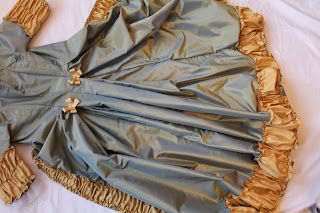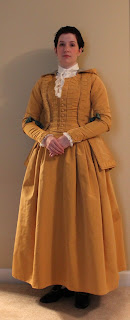Up this week is my new Robe a la Polonaise. It was started in *surprise* another workshop through Burnley & Trowbridge. This time the lovely Brooke Welborn taught the class during one of her trips back from Cairo; she has made an intense study of Polonaise gowns, beginning with her final project of apprenticeship at Colonial Williamsburg. I'll try to talk more about the history of the Polonaise gown in my next post, but a quick description; it was a popular style in the 1770s and 80s defined by the separate outer front which drapes away from the body. It can be a short jacket with no polonaising down to a longer gown (such as mine).
I chose an aqua silk taffeta for the main portion (petticoat and gown always match) and a yellow taffeta for the trim. Silk gauze for the sleeve ruffles and kerchief. Mine is worn over side-hoops. The fitted front bodice is pinned closed. All of the trimming is roll-hemmed at about 1/8", gathered with a whip stitch, and stitched down.
You can see how the outside fronts fall back, folding up a little over the hips. The bow is separate and pinned on.
The back shows the satin ribbons which hook up in back to gather up the skirt. You can also see two pleats taken in the front piece that are stitched down to the waist. The gown hem just barely passes the trim on the petticoat, which was intentionally done.
Laid out the gradual widening of the trim becomes more obvious. There are three thread loops along the side back seams of the skirt to help guide the gathers up the ribbon. The hem is rolled at about 1/4" all the way around to the neckline.
Here you can see how the outside front is only attached at the neckline, armscye, and side-back seam. The pleats are not stitched to the fitted bodice.
I chose to insert the top of the sleeves between lining and fashion fabric. The shoulder area is stitched folded over on the sleeve with a spaced backstitch. About half-way down the sleeve becomes exposed and all is stitched with a regular backstitch. This happens at the shoulder seam in back and where a seam *might* be on the front shoulder area depending on the fit.
The back is a very simple two pieces. The side-back seam is not done how it usually is on gowns, but with a turned, non-visible backstitched seam. The two pleats on the front are done with visible spaced back-stitching however.
I put a great deal of fullness into my skirt since I had wide fabric and wanted to! There are two pleats under the turn back on each side of the side-back seam (2" deep) and one under the center back (1.5" deep). The seams which run down the skirt are finished with a mantua-makers stitch. Hooks on the ribbons and thread eyes on the bows allow the polonaising to be released.
The petticoat is bound with linen tape and has about 3/8" hem. The ruffle reaches just below the regular hem. *Don't make the ruffle extend far below, it may seem like it saves fabric but you'll end up destroying the ruffle quickly with shoe buckles, mud, rocks, etc. Patching or darning a small area under the ruffle will never be seen, but you don't want to damage the ruffle itself if possible.
I know this is a garment which exists mostly in fashion plates, so if there's anything you would like more pictures of or clarification on, just ask!
You can also find a post on the co-ordinating pair of stays here.




























